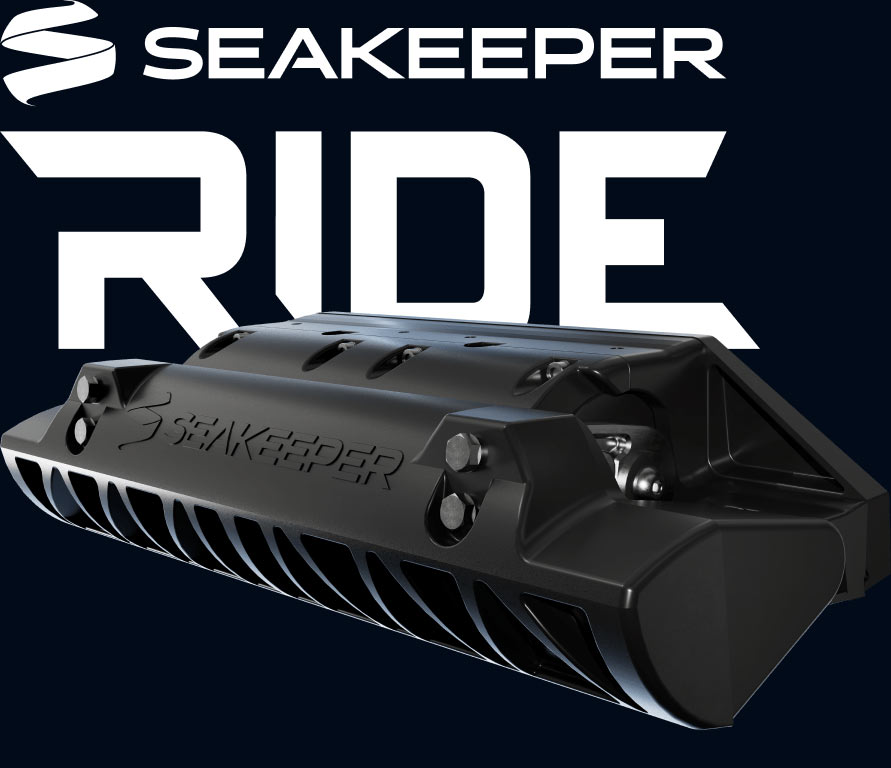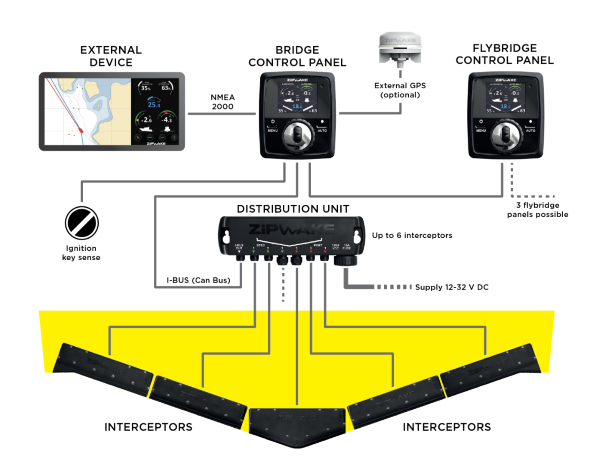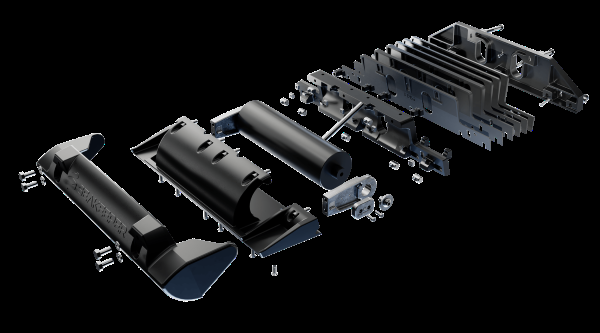Both Zipwake and Seakeeper Ride are automated trim systems for powerboats that offer underway roll and pitch control with devices mounted on the transom in place of traditional trim tabs. Zipwake’s devices are called interceptors, while Seakeeper calls their transom-mounted devices “controllers,” which are similar in design, though technologically different, to the rotary interceptors first introduced to the marine industry by Naiad in 1996. While both systems aim to accomplish the same goal of helping the boat ride steadily in its most comfortable and efficient state by automatically reacting to changing conditions and generating lift on the transom, there are some significant differences between the two products.
Product History
Zipwake interceptors have been around for more than a decade now, with the Series S product first launching 2014. The product line expanded in 2020 with the introduction of Series E interceptors intended for larger boats in the 40-100’ range, while Series S is made for boats in the 20-60’ range. The first Zipwake kit left the assembly-line in April 2015 and since then more than 65,000 systems have been delivered around the world and are in use on boats ranging from 16-feet to over 100-feet in length. To date, over 100 boatbuilders in North America are installing Zipwake systems on new builds. In 2025, Zipwake introduced the PRO series, which is five-times faster than the original product, and includes active pitch control, among several other new features. Learn more about PRO here.
Seakeeper as a company is better known for their gyro stabilizer, a much different product utilizing entirely different technology to stabilize a boat, which hit the open market in 2008. Seakeeper Ride has not been around as long, with the product launching in the summer of 2022. To date, they are being used by roughly 30 boatbuilders in North America.

Compatibility with Different Boats
Currently, Seakeeper Ride offers 4 models, all named for their width in millimeters: 450, 525, 600 & 750, as well as 5 more that combine two of the smaller ones, reaching 900, 1050, 1125, 1275 & 1500. The 450 is for boats up to 26’, the 525 for boats in the 27-30’ range, the 600 for boats in the 31-35’ range, the 750 for boats in the 37'-42' range, and the larger combined models for boats 43-55' in length. At this time there is no option for larger vessels as all of their models have just a 25mm stroke length, limiting the amount of potential lift generation. Both Seakeeper Ride and Zipwake require a flat transom surface for mounting the interceptors/controllers.
Zipwake offers eight different standard interceptor models, also named for their width in millimeters: 300S, 450S, 600S, 750S, 400E, 600E, 800E & 1000E. In addition, they offer chine interceptors in the 300S, 450S, 400E & 600E sizes which are designed to mount on the outermost edges on the transom of boats that have a reverse chine, optimizing roll stability by being as far outboard as possible. Zipwake also offers V-interceptors for mounting on a V-shaped hull providing lift at the very center of the hull, intermediate interceptors designed to be mounted between two outboard motors without being affected by ventilation, and tunnel interceptors for mounting over propeller tunnels on larger boats. In all, they offer 25 different shapes and models which include Series S interceptors with a 30mm stroke, and Series E interceptors with a 60mm stroke for providing more lift.
Zipwake’s wide selection of interceptor sizes and shapes make it compatible with just about any powerboat in the 20-100’ range, making it a strong option for an aftermarket refit if the transom is already cluttered with outboards, transducers and underwater lights. Because the interceptors can be mixed and matched throughout the product range, and a single system can run up to 6 interceptors at a time, multiple smaller interceptors can be installed to achieve the same performance as the larger ones. In all, there are Similarly, the Series E interceptors with a 60mm stroke generate more lift than the Series S interceptors (30mm stroke) making them a great option for the larger boats or for generating more lift in a smaller housing when transom space is limited.

System Components
Zipwake sells their systems in kits which come with two interceptors of the chosen size, the distribution unit, a control panel for mounting at the helm and standard cabling to connect the system together. Additional interceptors, control units, and cabling can be purchased separately. Zipwake also offers an integrator module, which can connect your Zipwake system to 8 different Multi-functional displays (MFDs) from different manufactures or wirelessly to smart devices.
Seakeeper Ride also comes in kits which include two "controllers," a software module and a distribution module. Seakeeper Ride does not come with a control unit for the helm included. It is meant to be controlled with select MFDs from Simrad, Garmin or Raymarine. There is a keypad with no screen that can be purchased separately in addition to the system if the boat does not have a compatible MFD.
Pricing
This table shows the listed retail price for a standard system from each manufacturer and does not include any add-ons or installation cost. The boat size column is an estimate of the size of boat each system is intended for, but is only a general guideline and exceptions apply.
System
|
Boat Size*
|
Retail Price*
|
| Zipwake 300S |
16'-25' |
$3,160.00
|
| Zipwake 450S |
25'-30' |
$3,500.00 |
| Zipwake 300S PRO |
16'-25' |
$4,050.00
|
| Zipwake 600S |
30'-35' |
$4,290.00
|
| Zipwake 450S PRO |
25'-30' |
$4,380.00 |
| Seakeeper Ride 450 |
19'-26' |
$4,500.00 |
| Zipwake 750S |
35'-45' |
$4,920.00
|
| Zipwake 600S PRO |
30'-35' |
$5,160.00 |
| Zipwake 750S PRO |
35'-45' |
$5,780.00
|
| Zipwake 400E |
30'-40' |
$6,430.00 |
| Zipwake 400E PRO |
30'-40' |
$7,260.00 |
| Seakeeper Ride 525 |
27'-30' |
$7,500.00
|
| Zipwake 600E |
40'-50' |
$9,760.00 |
| Seakeeper Ride 600 |
31'-35' |
$10,500.00 |
| Zipwake 600E PRO |
40'-50' |
$11,250.00 |
| Zipwake 800E |
50'-60' |
$12,010.00 |
| Zipwake 800E PRO |
50'-60' |
$13,550.00 |
| Zipwake 1000E |
60'+ |
$14,340.00 |
| Zipwake 1000E PRO |
60'+ |
$15,840.00 |
| Seakeeper Ride 750 |
37'-42' |
$17,500.00 |
| Seakeeper Ride 900 |
43'-55' |
$21,150.00 |
| Seakeeper Ride 1050 |
43'-55' |
$22,525.00 |
| Seakeeper Ride 1125 |
43'55' |
$25,075.00 |
| Seakeeper Ride 1275 |
43'55' |
$27,625.00 |
| Seakeeper Ride 1500 |
43'-55' |
$30,175.00 |
* Boat size for Seakeeper Ride is listed on their website, and for sizes 900 & up they recommend contacting their sales team for a recommendation. Zipwake boat sizes are estimated based on using the two interceptors in the listed kit. Zipwake does not list specific boat sizes for interceptors given that different models can be mixed and matched to fit any transom with up to 6 interceptors in one system, and they calculate the size and number of interceptors needed using a ratio of transom width to total interceptor span. Pricing as of August, 2025 in $USD.
Installation
While both Zipwake and Seakeeper Ride systems involve similar components and below-the-waterline installations on the transom, the installation process is different for each. The biggest difference is that Seakeeper Ride must be installed by one of their certified dealers or by a boat builder, and is not available for purchase and installation by the general public. Zipwake, on the other hand, is available for anyone to purchase and install with the aid of their detailed installation manual and videos.
Another major difference in the two installations is the way in which the Zipwake interceptors and Seakeeper Ride controllers are secured to the transom. Zipwake interceptors are installed with several fasteners while Seakeeper Ride controllers are installed by securing a back plate to the transom using a Methyl Methacrylic Adhesive (MMA) and no fasteners, then the rest of the controller is mounted to the backplate. This means the backplate of the Seakeeper Ride controller is essentially bonded permanently to the hull of the boat.
To properly secure the back plates to the transom, Seakeeper Ride’s installation manual calls for the removal of any and all paint and gel coat, exposing bare fiberglass. The installer must take extreme care not to expose bare fiberglass anywhere that won’t be covered by the backplate, as exposed fiberglass below the waterline is not good for the hull of the boat. Because of the required grinding and the adhesive curing time, the installation process for a Seakeeper Ride system will take significantly longer than a Zipwake system. Additionally for wiring the system, Zipwake offers plug and play wiring, while Seakeeper Ride does not.
Another difference is in the physical size of the Zipwake interceptors compared to the Seakeeper Ride controllers. Seakeeper Ride’s controllers are more complex in design, consisting of a transom plate, wedges, an actuator plate, a rotary actuator, a seal plate and a rotary blade. This design combined with their software gives them the ability to deploy or retract at a speed of 300mm/s. The design does make them significantly larger than Zipwake interceptors standing 8-9" off the transom depending on the wedges required. Zipwake interceptors have a lower profile, consisting of a back plate, electric servo motor, and a front plate, which includes the blade, standing just 2.2” (Series S) or 3.1” (Series E) off the transom. This makes fitting the Seakeeper Ride system into tight spots, like underneath a swim platform or kicker motor, more challenging. The larger profile also makes them more likely to foul fishing lines and be damaged when backing up to a dock or trailering.

Exploded view of Seakeeper Ride Controller
Final Thoughts
Both Zipwake and Seakeeper Ride systems aim to accomplish the same goal: improved ride stability at speed for powerboats. While each uses a different technology to accomplish this goal, they are similar systems in that they are both transom-mounted trim-tab alternatives that use built-in sensors to sense the motion of the boat and correct it automatically. Given that there is no objective data comparing the performance of the two systems, the decision of which to install on your boat can only be made based on other factors, like price, installation options, and physical fit on your boat.
Before choosing any system to install on your boat, it’s always best to consult marine professionals, both those that install the systems and those that use them. If you have any questions about Zipwake or would like any additional information, feel free to contact the experts at Imtra. To learn more about interceptors and how they compare to trim tabs, read our article on that topic here.